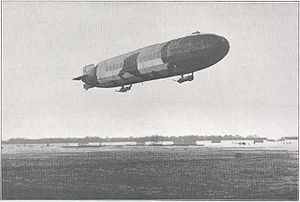LZ 41
The Zeppelin LZ 41 was Count Zeppelin's 41st airship and the eleventh zeppelin of the Imperial Navy with the military identification L 11 .
history
LZ 41 was the first zeppelin to be completed at the new shipyard in Löwenthal near Friedrichshafen. The first run of LZ 41 took place on June 7, 1915. The navy took over the airship under the identification L 11 . The commander of the airship became Oberleutnant zur See von Buttlar , who had already commanded L 6 .
L 11 was alternately stationed in Nordholz and in Hage for reconnaissance trips over the North Sea and for bombing raids on Great Britain . The ship was often used for both tasks. The ship attacked London on the nights of August 10, 13 and 18, 1915. The trip on 12./13. was canceled due to a severe thunderstorm over Harwich . At the same time as the two other voyages, the sister ship L 10 attacked the same target area. On October 13, 1915, L 11 took part in the squadron attack on England together with L 12 , L 14 , L 15 and L 16 . The last attack mission under von Buttlar was a squadron attack on Liverpool on January 31, 1916.
On February 9, 1916, Corvette Captain Schütze took over the airship, as Buttlar had given orders to take over the new Zeppelin L 30 . During the naval battle on the Skagerrak , L 11 was one of ten airships deployed and was able to report valuable information about the movement of parts of the Royal Navy off the Dutch coast to the German naval command via radio on June 1, 1916 . The British warships kept the airship, which was scouting about 1500 meters above sea level, under defensive fire. The commander of L 11 , Korvettenkapitän A. Schütze, wrote about it in the logbook : “All ships in sight immediately started the fire with energy, so that L 11 was temporarily caught in the fire of 21 large and many small ships. Even if the fire was unsuccessful, the large projectiles and the nearby shrapnel caused such severe tremors in the structure of the ship that it seemed advisable to increase the distance by taking appropriate measures. "
L 11 , under the command of Kapitänleutnant Hollender since November 12, 1916, carried out a total of 31 reconnaissance and 12 attack trips with 15,543 kg bombs under its three commanders. Together with its sister ships L 13 , L 14 and L 16 , L 11 was one of the most successful airships from a military point of view. Together, these four ships carried out 162 reconnaissance trips and 56 attack trips and dropped 17% of the total bombs (approx. 75 t) dropped by airships.
Whereabouts
L 11 last served as a training ship under the lieutenant captain of the Reserve Blew. LZ 41 / L 11 was disarmed as obsolete on April 25, 1917 in Hage. During its service time as a front-line airship, it made 118 trips. 276 more journeys followed during school operations.
Technical specifications
- Carrying gas volume: 31,900 m³ hydrogen
- Length: 163.50 m
- Diameter: 18.70 m
- Payload: 15 t
- Drive: four six-cylinder Maybach engines, each with 210 hp (154 kW)
- Speed: 26.7 m / s
See also
literature
- Hans-Jürgen Becker / Rudolf Höfling: 100 years of airships. Motorbuch Verlag, Stuttgart 2000, ISBN 3-613-02071-8
- Horst Freiherr von Buttlar : Zeppelins against England. Amalthea publishing house, Zurich / Leipzig / Vienna 1931
- Ernst A. Lehmann : On air patrol and world travel. Wegweiser-Verlag, Berlin 1936
- Peter Meyer: Airships - The History of the German Zeppelins. Bernard & Graefe Verlag, Bonn 1996, ISBN 3-7637-5951-4
- Hans von Schiller : Zeppelin - pioneer of world air traffic. Kirschbaum-Verlag, Bad Godesberg, 1966
Individual evidence
- ↑ Becker / Höfling: 100 years of airships , p. 148
- ^ Meyer: Luftschiffe , pp. 46, 52
- ↑ a b c Meyer, p. 52
- ↑ according to Schiller: Zeppelin , pp. 54,59, the zeppelin came home after a 22-hour journey with a full bomb load since the targets of the attack could not be clearly identified
- ^ Lehmann: Auf Luftpatrouille und Weltfahrt , p. 121ff.
- ↑ Schiller: Zeppelin , p. 158

